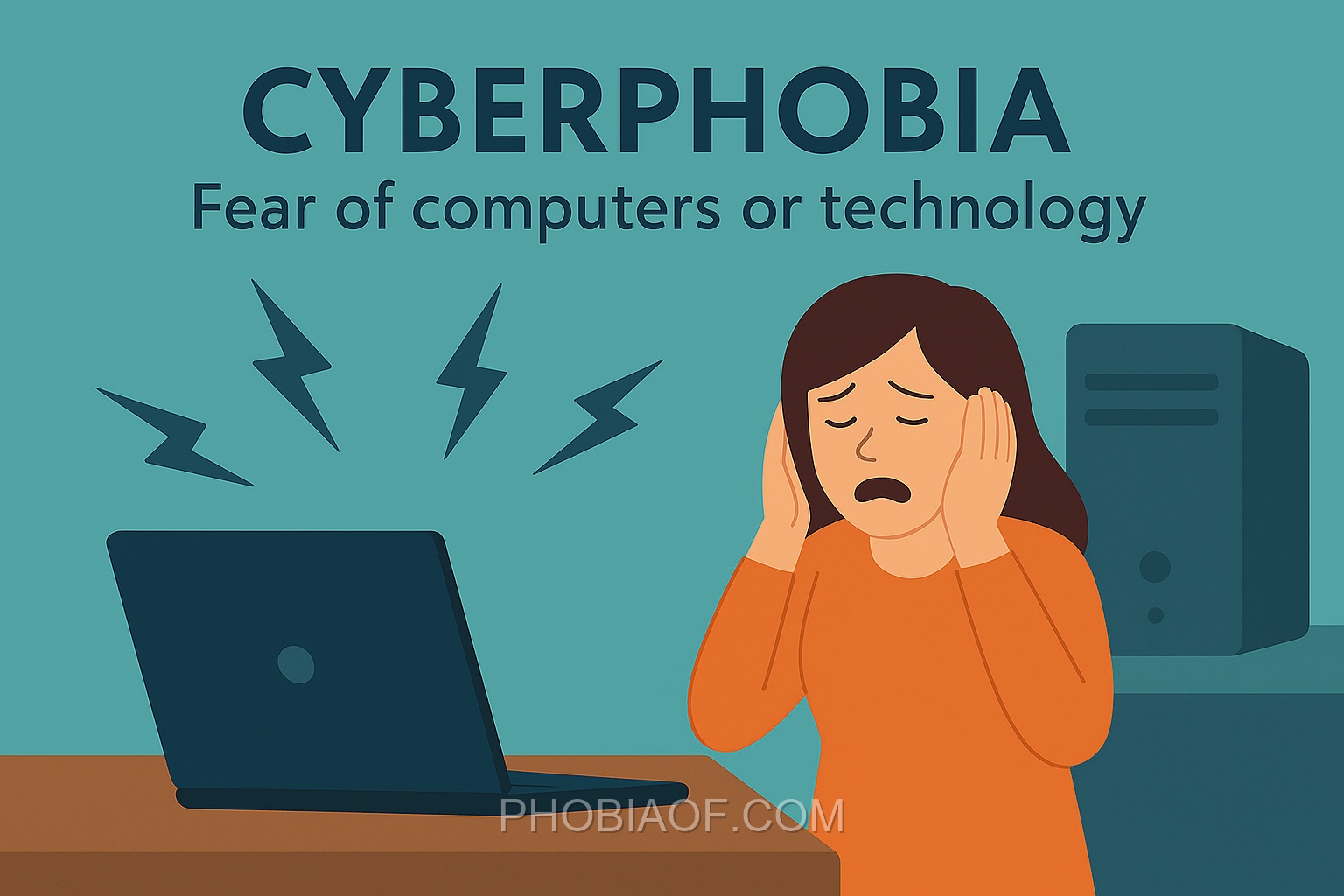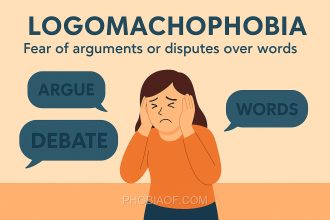Have you ever felt overwhelmed or anxious at the thought of using a computer or navigating the latest technology? If so, you’re not alone. These feelings might be related to a condition known as Cyberphobia.
Cyberphobia is a term derived from the Greek word “kybernetes” meaning “steersman” or “governor” and the word “phobia” which means fear. Put simply, Cyberphobia is the fear of computers or technology. It’s more than just a reluctance to engage with technology; it’s a deep-seated anxiety that can impact everyday life.
For some people, Cyberphobia might mean avoiding computers altogether, which can lead to challenges in both personal and professional settings. This fear can manifest as anxiety, stress, or a sense of being overwhelmed when having to use technology. It can affect individuals in various ways, including:
- Hesitance or refusal to learn new technological skills
- Difficulty in performing tasks that require technology
- Increased stress levels when confronted with technological issues
Understanding Cyberphobia is crucial in our increasingly digital world. By recognizing and addressing these fears, individuals can seek help and gradually build confidence in their technological abilities. If you or someone you know struggles with Cyberphobia, know that support and resources are available to help navigate this challenge.
Causes of Cyberphobia
Cyberphobia is the fear of computers or working with technology. This phobia can significantly impact an individual’s daily life, especially in a world increasingly reliant on digital technology. Understanding the potential causes of cyberphobia can help in addressing and alleviating this fear.
Genetic Predisposition: Like many other phobias, cyberphobia can have a genetic component. Individuals with a family history of anxiety disorders may be more prone to developing specific fears, including those related to technology.
Traumatic Experiences: Negative experiences involving technology, such as a severe data breach or identity theft, can instill a deep-seated fear of technology. Such traumatic incidents may lead to an association between technology use and feelings of vulnerability or loss of control.
Learned Behavior from Others: Observing family members or peers who exhibit fear or mistrust of technology can influence one’s own perceptions. If a parent or a close individual consistently expresses anxiety about technology, it may be internalized by others around them.
Psychological and Environmental Factors: Psychological factors such as a general fear of change or a tendency to feel overwhelmed by complex systems can contribute to cyberphobia. Additionally, environmental factors such as rapid technological advancements can create a sense of alienation or apprehension in some individuals.
Interesting Theories and Research Findings: Some theories suggest that cyberphobia may be linked to a broader apprehension about the rapid pace of technological change and its implications for society. Research has also indicated that individuals with lower levels of computer literacy are more susceptible to experiencing anxiety related to technology.
Understanding these causes is the first step in addressing cyberphobia. By identifying the root of the fear, individuals can seek appropriate strategies to manage and overcome their anxieties, thereby improving their interaction with technology.
Symptoms of Cyberphobia
Cyberphobia is characterized by an intense fear or anxiety related to computers, technology, or the internet. This phobia can manifest in various ways, affecting both the physical and emotional well-being of individuals. Recognizing these symptoms is crucial for understanding and managing the condition effectively.
Common Physical Symptoms:
- Panic attacks marked by sudden feelings of intense fear or distress.
- Excessive sweating, even when not physically exerting oneself.
- A rapid heartbeat, often accompanied by palpitations.
- Shortness of breath or a feeling of choking.
- Trembling or shaking, which can be visible or felt internally.
- Dizziness or lightheadedness, contributing to a sense of instability.
- Nausea or gastrointestinal distress when faced with technology-related situations.
Emotional and Behavioral Symptoms:
- Overwhelming dread or apprehension when thinking about or encountering technology.
- Avoidance of situations involving computers or the internet, leading to social withdrawal.
- Difficulty concentrating due to persistent worry about technology use.
- Feeling powerless or out of control in environments that require digital interaction.
- Increased irritability or frustration when technology is unavoidable.
- Seeking reassurance from others about technology-related fears.
If left unmanaged, the symptoms of cyberphobia can significantly interfere with daily life, limiting one’s ability to function effectively in both personal and professional settings.
Treatment for Fear of Computers or Technology
Overcoming the fear of computers or technology, known as cyberphobia, is entirely possible with the right approach and support. Many individuals have successfully managed and even conquered this phobia, and you can too. With time, patience, and the correct strategies, you can reduce your anxiety and increase your comfort with technology.
Therapeutic Approaches:
- Exposure Therapy: This therapy involves gradually exposing yourself to the source of your fear in a controlled and safe manner. By slowly increasing your interaction with technology, you can desensitize yourself to the fear response. Start with simple tasks, such as turning on a computer, and progress to more complex activities as you become more comfortable.
- Cognitive-Behavioral Therapy (CBT): CBT helps you identify and change the negative thought patterns that contribute to your fear. By challenging these thoughts and replacing them with more positive, realistic ones, you can reduce your anxiety and improve your interaction with technology.
- Counseling: Speaking with a counselor or therapist can provide you with a safe space to explore your fears and develop coping strategies. They can offer personalized advice and support to help you navigate your journey toward overcoming cyberphobia.
Self-Help Coping Techniques:
- Relaxation Exercises and Meditation: Techniques such as deep breathing, progressive muscle relaxation, and meditation can help reduce anxiety and promote a sense of calm when facing technology-related fears.
- Support Groups: Joining a support group can connect you with others who are experiencing similar challenges. Sharing experiences and coping strategies can be incredibly empowering and provide additional motivation and support.
Medication:
In severe cases of cyberphobia, medication such as anti-anxiety drugs might be prescribed. However, it’s important to focus on therapy and coping skills as the primary means of treatment. Medication should be considered a supplementary option and used under the guidance of a healthcare professional.
Remember, seeking professional help is a positive step if your phobia is interfering with your daily life. Mental health professionals are equipped to guide you through this process and help you regain control. By taking these steps, you’re prioritizing your well-being and paving the way for a future where technology can be a tool rather than a source of fear.
Conclusion
In understanding cyberphobia, or the fear of computers and technology, it is essential to recognize the underlying causes and symptoms that contribute to this increasingly relevant issue. By educating ourselves about the origins of this phobia, whether rooted in past experiences, lack of exposure, or anxiety about the rapid pace of technological advancement, we can begin to demystify and address the fear effectively.
Identifying the symptoms, such as avoidance, anxiety, and distress when faced with technology, empowers individuals to tackle the phobia head-on. Armed with this knowledge, readers can take proactive steps toward overcoming their fears, transforming what once seemed like insurmountable obstacles into manageable challenges.
Remember, you are not alone. Many people have successfully managed or even overcome their phobias with time, patience, and the right support. There is a wealth of resources available, and reaching out for professional help is a courageous and positive step. Consider speaking with a therapist or consulting a doctor if you feel that cyberphobia is impacting your quality of life. Support networks and professional guidance can provide the necessary tools and strategies to help you regain confidence and comfort with technology.
In your journey to conquer cyberphobia, embrace each small victory and remain hopeful. With understanding, support, and determination, it is entirely possible to navigate and thrive in our technology-driven world.






